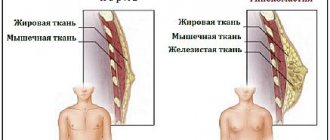This disease can be either unilateral or bilateral, that is, it affects one breast or both. During development, a person may feel heaviness in the area of the mammary glands, lumps may be felt, nipples may change their shape, etc.
The main danger of the pathology is that it can lead to malignant neoplasms in the mammary glands.
There are several types of gynecomastia, let’s look at what each of them means:
- true - with this type, the breast grows due to the proliferation of glandular tissue, and a lump can be felt under the nipple;
- false - typical for overweight men, breasts grow not due to glands, but due to fat;
- mixed in nature - both glandular tissue and adipose tissue grow, and dominance of one of them is usually noted.
In order for the treatment of gynecomastia in a man to be successful, it is necessary to accurately identify the cause, then you will find out which doctor treats this pathology.
Symptoms of gynecomastia
Usually men notice that something is wrong with them only when the breasts become noticeable; all other symptoms, as is correct, can be explained by fatigue, age, individual characteristics, or the person simply does not pay attention to them. Next, we will tell you how to determine the onset of gynecomastia.
How can you understand that you have gynecomastia and not make the disease worse? Here are the main symptoms that should prompt the patient to see a doctor:
- Sexual function is gradually inhibited, libido decreases;
- The timbre of the voice may change, usually it becomes higher;
- there may be a feeling of discomfort and heaviness in the sternum;
- mild itching in the chest area;
- increased nipple sensitivity;
- cases of causeless mood swings are becoming more frequent, depression and apathy are possible;
- when palpating the breast, lumps and lumps can be detected;
- enlarged nipple areolas or scanty discharge from them;
- gradual or rapid enlargement of the mammary glands.
Patients with gynecomastia may experience symptoms in one breast or both at once.
Gynecomastia is characterized by three stages of development:
- developing - a stage at which the disease is reversible if treatment with medications is started in time, it can last up to six months;
- intermediate – irreversible formation of glandular tissue occurs, symptoms begin to appear clearly, lasting from 4 to 12 months;
- fibrous – connective tissue is actively forming and growing, adipose tissue begins to form, the process cannot be reversed with the help of medications.
The photo below shows men with obvious gynecomastia.
Complications after gynecomastia
| Types of complications | Causes and nature of occurrence | Approximate percentage of patients experiencing a complication |
| Hematomas | Blood clots forming under the skin due to microvascular damage | 98 |
| Seromas | Accumulation of lymph between skin and muscle tissue | 98 |
| Tissue atrophy | The cause of this complication after gynecomastia is insufficient blood circulation and lymph exchange. | 15 |
| Visible scars | Connective tissue can grow due to poor nutrition of cells; poor fixation of the skin leads to their displacement and stretching. | 59 |
| Inflammatory processes | Infection sometimes gets into the stitches because they are not closed tightly enough | 8 |
| Slow tissue fusion | Prolonged regeneration processes are provoked by insufficient massaging of the damaged area | 30 |
Causes of gynecomastia in men
In nature, in males, the mammary glands are underdeveloped and the nipples are not designed to perform any role. However, there are a number of reasons due to which breasts begin to actively develop along female lines.
Typically, the appearance of gynecomastia in men is associated with the following processes in the body:
- the presence of tumors in the pituitary gland provokes excessive production of prolactin, which is a factor in the development of gynecomastia;
- hypothyroidism (insufficient production of thyroid hormones) can be a factor in increased production of prolactin, which also leads to enlarged mammary glands in men;
- excessive production of female sex hormones estrogen and inhibition of androgens (male sex hormones) - this condition can be caused by many factors, for example, tumors of hormone-producing organs (testes, adrenal glands, pituitary gland, etc.) or various inflammatory processes of the reproductive system;
- some diseases also provoke dysfunction of the hormonal system and can lead to the development of this pathology: diabetes mellitus, obesity, tuberculosis, various pathologies of the thyroid gland, HIV, cirrhosis of the liver, chest injuries, etc.;
- taking hormones and hormone-like drugs (estrogen-containing drugs, steroids, captopril, reserpine, etc.);
- a provoking factor for enlarged mammary glands in men can be drug addiction, taking heroin, marijuana, etc.;
- alcohol abuse, alcoholism - in addition to the fact that alcohol can cause various diseases that adversely affect not only the hormonal system, but also all functions of the body, it has a high calorie content, which leads to weight gain. There is an opinion that beer makes breasts grow because it contains a lot of estrogens - this statement is not entirely true. Beer has a high calorie content and a fairly low percentage of alcohol, which allows you to drink it a lot and for a long time, as well as snack on various high-calorie foods, which leads to obesity and the appearance of excess fat in the chest.
Why there are complications after surgery and how to avoid them
The most common mistake of operated men is the reluctance to wear compression garments or insufficient use of them. Seromas and hematomas are common after gynecomastia surgery, just like any other. During the first 2-4 days, swelling caused by the accumulation of blood or lymph is inevitable. They usually go away on their own within 8-10 days. The main thing is not to make this process protracted and to disperse the accumulations in order to avoid another operation to remove them. This is why any surgeon will recommend wearing compression garments.
Why not use a compression bandage or bandage? They are not comfortable enough for this zone; they will shift and slide down. In addition, the compression level of such products is not calculated; it is the same everywhere. The patient and the one doing the dressing adjust the tension and level of compression independently, and it is easy to make a mistake and tighten too much.
Special medical underwear for rehabilitation after gynecomastia has precisely calculated compression and the degree of pressure on the tissue. Fluids will circulate correctly. At the same time, the fabrics will receive a massage throughout the entire wearing time. It also protects compression garments well from infection. It is extremely important to treat the seams with an antiseptic until they heal. The slightest infection during this period can result in inflammation. Where to buy compression garments?
Consequences of gynecomastia
Gynecomastia, which is not treated in time, will progress, the tissue will undergo scarring and it will no longer be possible to remove it with medications. In this case, you will have to resort to surgery to remove the overgrown mammary glands.
Since gynecomastia occurs due to dysfunction of the hormonal system due to disruption of the functioning of certain organs, prolonged absence of treatment can lead to the development of tumors, the formation of metastases and other diseases of organs and systems.
Also, patients with gynecomastia may experience psychological problems, this is especially common in adolescents.
Possible complications during the recovery process
Any surgical procedure carries a risk of side effects. The healing process takes place individually, depending on the general condition of the body and the constitution of the patient. In most cases, complications do not pose a health risk and disappear within a few weeks. In order for healing to proceed faster, you need to follow the doctor’s recommendations for caring for the operated area and follow a gentle regimen.
Separately, it is worth paying attention to the human factor. If you consult an inexperienced doctor without the proper qualifications, you may end up with an uneven breast shape with pronounced asymmetry.
Swelling and bruising
The reason for the formation of a hematoma is the accumulation of blood under the skin. This is a normal occurrence after mammoplasty. The extent of swelling can vary from a limited area around the chest to the abdominal area. The return to the natural anatomical appearance occurs after 2-3 weeks. To speed up this process, you need to exclude physical activity during this time and prevent skin contact with direct sunlight.
We can finally talk about the elimination of edema after removal of gynecomastia in men after 1.5-3 months. Hematomas resolve within 14 days, to speed up the process, ointments are prescribed. To reduce swelling, 2 weeks after plastic surgery, you can perform a light lymphatic drainage massage, after consultation with your doctor. In this case, the patient should not experience pain.
Seromas
The complication is caused by the accumulation of serous fluid under the skin. Does not require special therapy, goes away on its own. The doctor monitors the process of skin regeneration and, if necessary, can forcibly pump out the contents. Prevention of seroma formation involves wearing compression garments and working out the operated area using a set of exercises. Their task is to restore blood supply to the male mammary glands.
Inflammatory process
Drug therapy is prescribed for therapeutic and prophylactic purposes to prevent and combat bacterial complications. In addition, the action of the drugs is aimed at accelerating healing. The treatment regimen includes:
- painkillers;
- antibacterial agents;
- ointments for external use with a healing and anti-edematous effect;
- steroids according to indications (for hormonal disorders).
The drugs are selected depending on the complaints by the specialist who performed the operation.
Seals
The reason for the formation of this symptom is the incomplete removal of breast tissue. The occurrence rate is infrequent; its presence can be determined only six months after the operation. If a lump forms after eliminating gynecomastia, this may be due to an inflammatory reaction of the adipose tissue. Over time, it should decrease in size, and you should periodically see a doctor to evaluate the condition. If there is no positive dynamics, a repeat operation is performed.
Scarring
If the excision is carried out carefully, the scars are not visible. Much depends not only on the professionalism of the doctor, but also on the area of the surgical field and the location of the incision. The rehabilitation period plays a big role; if you follow the specialist’s recommendations, the likelihood that scars will remain is less. With endoscopic removal or laser vaporization, the marks are minimal; with a paraareolar incision, the seam becomes less noticeable after 4-5 months.
For greater aesthetics, doctors use silicone threads for sutures. After complete healing, the scars will not be noticeable to others; this is an important psychological aspect.
Nipple dips
This is a complication that is typical when mammoplasty is performed by surgeons who do not specialize in this field. Their profile does not provide for aesthetics. This will happen if the formed space is not filled with adipose tissue. A violation of the surgical technique is not only the failure of the nipples and areolas, but subsequently they can grow to the pectoral muscle.
If the nipple has collapsed after surgery to remove gynecomastia, its anatomical shape may also change. To prevent this complication, a base of subcutaneous tissue is formed under the operated area. This method is effective for gynecomastia of different sizes.
Diagnostics
Only a doctor can diagnose a patient after a personal consultation. At such an appointment, the specialist will palpate the chest and armpits to determine the condition of the lymph nodes and mammary glands; the doctor will also need to collect the patient’s medical history, so the patient needs to answer questions as accurately as possible.
If breast hypertrophy in men is noticeable at the fibrotic stage, then at earlier stages it may be less pronounced, so the doctor may prescribe additional tests. Some diagnostics are prescribed to determine the nature of the breast tissue and detect pathologies there. So, the following types of diagnostics can be prescribed:
- blood analysis;
- determination of the level of sex and other hormones in the blood;
- determination of the concentration of thyroid hormones in the blood;
- ultrasound examination of the mammary glands and adjacent lymph nodes;
- mammography;
- a biopsy of breast tissue may be prescribed;
- CT scan of the adrenal glands.
Blood type and Rh factor
Blood test for HIV infection (AIDS, antibodies to HIV) - detection of antibodies that have arisen in the body in response to infection with the human immunodeficiency virus (HIV).
A blood test for syphilis (Wassermann reaction, RW) - just like a blood test for HIV, this is one of the mandatory tests for any hospitalization. The analysis is the identification of a specific reaction to a sexually transmitted disease - syphilis.
Hepatitis B virus testing is also done before any surgery. The hepatitis B virus has several antigens; they and antibodies to them are determined to diagnose the severity of the process, its activity (reproduction of the virus), to monitor the effectiveness of treatment, and to assess the strength of the immune system.
To detect hepatitis C, blood tests are used to look for antibodies or the virus itself. To screen for hepatitis C, the ELISA method (immunofluorescence assay) is used, and the immunoblot method (RIBA) is used as a confirmatory test. PCR can detect hepatitis C virus not only in blood serum, but also in liver tissue. Test results for HIV, syphilis and hepatitis are valid for 3 months from the date of delivery.
A general urinalysis includes an assessment of the physicochemical characteristics of urine. Indications for the purpose of analysis are diseases of the urinary system; suspicion of diabetes mellitus, assessment of the toxic state of the body, assessment of the course of the disease. A general urine test, like a general blood test, is also taken before any type of surgery; its results are valid for 10 days.
There are also a number of instrumental studies that you will need to undergo. In particular, this is an electrocardiogram - a method for diagnosing cardiovascular diseases, in which the electrical impulses of the beating heart are recorded using special devices - electrocardiographs. The doctor must be sure that your heart will withstand the operation - otherwise it may become a contraindication. Electrocardiogram data is valid for 1 month from the date of examination.
You must definitely consult a phlebologist - a specialist in the diagnosis and treatment of vein diseases and have a duplex scan of the veins of the lower extremities. The results of this examination are also valid for 1 month.
Also included in the mandatory examination plan before surgery is a consultation with a gastroenterologist. If prescribed by a doctor, gastroscopy can be performed - examination of the upper gastrointestinal tract (esophagus, stomach, duodenum) using a flexible endoscope.
You will need fluorography (or chest x-ray), which will identify the initial forms of tuberculosis, sarcoidosis, inflammatory and oncological diseases. The duration of the results is up to 1 year.
In addition, any patient undergoes a consultation with a therapist and other specialists according to indications (gynecologist, urologist, mammologist, etc.). After receiving the examination results, the specialist issues a conclusion whether the operation can be performed. Immediately before the operation, you will be consulted by an anesthesiologist so that it becomes clear what type of anesthesia, duration and dosage to give you.
Which doctor should a man see for gynecomastia?
If you suspect the development of gynecomastia in a man, you can contact the following specialists:
- therapist;
- urologist;
- endocrinologist
Most often, this pathology is treated by an endocrinologist, since the root cause of breast growth is the improper functioning of the hormonal system.
I am an endocrinologist, candidate of medical sciences, associate professor Georgiy Nikitich Romanov, an experienced specialist with more than 20 years of work experience. I was able to help many patients overcome their illness and live a normal life. As a specialist, I have extensive up-to-date knowledge that helps me successfully treat patients with true gynecomastia.
I not only conduct appointments at the clinic, but also offer paid consultation services. You can contact me through any of the presented instant messengers or social networks: VKontakte, Direct, Skype, Whatsapp, Telegram, Viber.
Gynecomastia or not?
This question torments more than one thousand men. Based only on external characteristics, it cannot be said unequivocally that gynecomastia occurs. Some men have fuller breasts than others, and the shape of men's breasts varies greatly from person to person.
If a man believes that he has gynecomastia, then he will behave as if he has it.
Observations of male breasts have shown that there are some external signs characteristic of this disease:
- The chest of healthy men is not rounded. The nipple and areola are flat and small in size. The geometric shape of the breast is an angle. The appearance is elastic. The nipples don't show through the shirt.
- The breasts of men suffering from gynecomastia have a round shape. Areolas and nipples clearly protrude through clothing. The appearance is soft and saggy. Visually, the breasts resemble more a woman's than a man's.
Corrective surgery
The patient may require repeated surgery if he himself mechanically damaged the mammoplasty area. Improving the result is necessary with massive tissue removal. Also, the risk of complications increases in direct proportion to age. At the same time, with a large area of plastic surgery, the blood supply may deteriorate. In the absence of proper therapy, necrosis of the nipple will develop. If its location is changed, the consequence is loss of sensitivity, which sometimes does not resume. Correction of the result will be required if the nipples are located at different levels.
Relapse
Re-development of gynecomastia is possible with unprofessional surgery. It is necessary to understand that no doctor will give a 100% guarantee that it will not appear again. The cause of the pathology is of great importance; only its elimination increases the chances of a complete recovery.
Measures aimed at preventing the development of the disease:
- observation during the rehabilitation period;
- proper nutrition;
- eliminating the causes of pathology;
- excluding the use of steroids and phytoestrogens.
If the disease was triggered by hormonal imbalances, the risk of relapse is higher.










